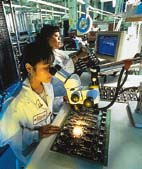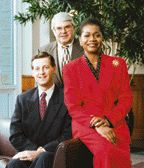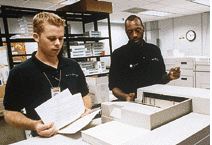Profiles in Quality:
The 1997 Baldrige Award Winners by Elizabeth R. Larson "The 1997 award winners once again prove that U.S. companies can improve their competitiveness and their bottom line, even as they make their companies better places to work and their communities better places to live." --President Bill Clinton Now in its 10th year, the Malcolm Baldrige National Quality Award has honored more than 30 organizations of different sizes from industries around the United States. Recognizing achievements in quality and business performance, the award has evolved into a much coveted validation for companies dedicated to implementing quality processes. In October 1997, President Bill Clinton named the 1997 Baldrige Award winners. 3M Dental Products Division and Solectron Corp. were honored in the manufacturing division; Merrill Lynch Credit Corp. and Xerox Business Services won in the service category. No award was given in the small business category. "The Baldrige Quality Award is a blueprint for success to help U.S. companies attain and retain market leadership in the 21st century," Clinton said at the awards announcement. "The 1997 award winners once again prove that U.S. companies can improve their competitiveness and their bottom line, even as they make their companies better places to work and their communities better places to live."  3M Dental Products 3M Dental Products
3M Dental Products Division manufactures and markets dental products worldwide, including restorative, crown and bridge materials; dental adhesive; and infection-control products. Four hundred of 3M DPD's 700 employees are based at its St. Paul, Minnesota, headquarters and at the division's manufacturing and distribution facility in Irvine, California, with others located around the United States. The company began using the Baldrige criteria in 1990 to do self-assessments. In 1994, 3M DPD became the first winner of California's U.S. Senate Productivity Gold Level Award, which is based on the Baldrige. That same year, the company applied for the Baldrige. In 1997, on their fourth try, 3M DPD won the award. "Before we ever applied for the national award, we had trained Baldrige examiners look at us," says Duane G. Miller, 3M DPD's quality manager. The award provided outside validation for the company's quality processes, he says. The Baldrige competition and the recognition also have proved positive for employees, suppliers and customers. The process helped 3M DPD clarify its customer focus. "When we began the process in 1990, we weren't sure who our customer was," notes Miller. The company now considers dentists its primary customers and has developed processes to target their needs, including follow-up after purchases and information gathering for new product lines. Miller estimates that his company serves 120,000 dentists throughout the United States. 3M DPD has doubled its sales and market share over the last decade, leads its industry in overall supplier and customer satisfaction rates, offers innovative new products, retains high employee satisfaction rates and provides a leadership role in developing a code of ethics for the dental industry. The company holds registrations to a variety of standards, including ISO 9001, ISO 9002, ISO 14001, EN 46002 and the CE Mark. The company hasn't yet discussed what changes and improvements it will implement within the next five years. "I don't see us changing anything that we do in terms of the processes that we work on," observes Miller. "I think we all recognize that this is going to change our lives."  Solectron Corp. Solectron Corp.
Solectron Corp., headquartered in Milpitas, California, provides a variety of electronics design and manufacturing services to original equipment manufacturers. The first company to win the Baldrige Award twice, Solectron also has won quality awards in California, North Carolina, Texas and Malaysia. The company attributes its success to numerous factors, including a system to track customer satisfaction on a weekly basis, a reduction of hazardous wastes and chemical emissions, and Solectron University, which supports Solectron's policy to "hire for traits--train for skills." The Baldrige criteria helped the company create its quality initiative, says Rich Allen, Solectron's quality director. "We were actually looking for what might be called a quality direction," he recalls. "We had a lot of quality tools, but we really didn't have a road map or direction. The Baldrige criteria identified key elements that we had already aligned our company to, such as leadership driving the quality program focused on customer satisfaction. We found that the criteria of applying and receiving feedback was very healthy and worked to our advantage for making improvements in a very effective way." In 1989, the company submitted its first Baldrige application. They applied three times before winning the first time in 1991. Once an organization has won, it must wait five years before applying again. "The question that always comes to Baldrige winners seems to be, 'What are you going to do next?' " remarks Allen. In response, Solectron continued with what it was doing, which involved applying for regional and state Baldrige-based awards. Two-and-a-half years after winning its first Baldrige, the organization implemented an internal Baldrige-assessment program. Each Solectron site writes a Baldrige application every 15 months to two years. Senior executives at the sites, using the same criteria as Baldrige examiners, then become the internal examiners for Solectron locations worldwide. The company now also uses the Baldrige process on new facilities. Winning the Baldrige for the second time meant more people shared in the celebration. Solectron had fewer than 2,000 employees in 1991 and now employs more than 18,000 people at 17 locations worldwide. "It did mean a lot to them," says Daniel Perez, Solectron's vice president for corporate communications and chief administrative officer. "These sites grew up using this criteria in order to drive their business, and they saw the validation from the external group that they're on the right path." What's ahead for Solectron in the next five years? "Our system has been reinforced by winning and by using the Baldrige process," notes Allen. "I don't see any reason why we should change the system. Five years from now, we will still be using the system, as far as I can see."  Merrill Lynch Credit Corp. Merrill Lynch Credit Corp.
Merrill Lynch Credit Corp. provides liability management services, including home financing, personal credit, and investment and business financing. The company's 830 employees, known as partners, market and sell all MLCC products through a nationwide network of more than 14,000 financial consultants. The organization, headquartered in Jacksonville, Florida, includes 29 district offices located throughout the United States. The company won the Baldrige on its first try. The company's win resulted from thorough preparation, says Kevin O'Hanlon, MLCC president and chief operating officer. "We applied for the Florida Governor's Sterling Award two times prior," he explains. "We knew what the process was going to entail; it wasn't fresh out of the box." MLCC put the Baldrige criteria to work in order to expand its business. "We've gone through some explosive growth in people as well as in the products that we offer," says O'Hanlon. "In 1993, we figured that, if we wanted to continue to grow at the pace we had started to grow at and maintain the quality level of service that we had always provided, we better put in a formal business-planning process. We used the Baldrige criteria as a basis for the system that we put in place. We then decided to try for the Florida Sterling Award, which uses a similar criteria to the Baldrige." The feedback reports from the Sterling Award helped the company focus on what changes to implement. After going through the Sterling Award process for the second time and winning, MLCC decided to try for the Baldrige. "We believe that everything we do is a way to learn," continues O'Hanlon. The company doesn't strive for perfection, he adds. "We strive for excellence. The Baldrige process taught us that through continuous improvement, you'll never achieve perfection. But, as long as you're striving for excellence, you'll always get better at what you do." The Baldrige criteria provides a way to take a step back and look at what you're doing, observes O'Hanlon. "Sometimes you get so embroiled in the day to day, you miss the details," he says. "Our goal was to become a better company. The award that we won was important, but it was really a verification that the system we put in place was right." MLCC plans to implement new improvements once it has reviewed the Baldrige examiners' feedback report. O'Hanlon hopes the company will continue not only to grow rapidly but, more importantly, provide excellent service to its customers. "We've worked very hard over the last seven years to earn a reputation within the firm of providing a high quality of service and earning the respect of the financial consultants," he says. It's important for organizations interested in applying for the Baldrige to understand how the criteria relates to their respective businesses, emphasizes O'Hanlon. "There are things within the Baldrige criteria that we will probably never adopt," he notes. "But it gives you a terrific road map to help you do a self-assessment, to put in place a continuous improvement process. If you're going through it for the right reasons--to make the company better and not just to win an award--then it will give you a tremendous blueprint to be a better organization. If you're thinking it's going to help you achieve perfection, you're going to be let down." O'Hanlon believes MLCC won the Baldrige, in part, because it involved all employees. "This was not a top-down driven process," he adds. "We asked our people if they had a desire to try to win the Baldrige award. This was something that they really wanted."  Xerox Business Services Xerox Business Services
Xerox Business Services provides document outsourcing and consulting, including on-site management of mailrooms and print shops, as well as the creation, production and management of documents. With headquarters in Rochester, New York, XBS employs 14,000 people and handles more than 2,000 customer accounts in 35 countries. Xerox Corp. now has two Baldrige Awards under its belt, counting this recent achievement. The first came in 1989 when Xerox Business Products and Systems won. "We've been very fortunate," comments John Lawrence, a Xerox Business Services partner and the leader of the Baldrige core team. "We've applied twice and, in both instances, we won it the first time we applied. But that's a little bit misleading. In effect, we apply for the Baldrige every year because the Xerox Management Model was built off of the Baldrige and the other 22 awards that we've won around the world." Lawrence notes that Xerox Corp. has experienced a tremendous evolution. "We were confronted with a crisis of survival," says Lawrence. "The marketplace was changing very rapidly, and we were confronted with having to change." The company got into trouble in the 1970s and 1980s after decades of having a virtual monopoly over its market. "We got a little too arrogant," admits Lawrence. "We lost sight of the customer. The Japanese were taking aim at the markets that we were in. We were arrogant enough to think that customers would love what we produced just because we were producing it. And the Japanese taught us the lesson of understanding and listening to the marketplace and responding to it. It took us a while to wake up to that. We had to change the culture of Xerox Corp." The company faced challenges involving customer satisfaction, credibility and service organization. "What we've done has revolved around three major themes, the first being that customers are at the center of everything that we do," explains Lawrence. "The second is that we're continuously improving everything that we do. The third is we're continuously learning, and in today's world, where the market demands that you be fast, flat and flexible, we needed to internalize that learning and bring it back to the marketplace in the form of added value." The company created a change strategy involving experimentation and the Xerox Management Model, which consists of the values, objectives, mechanisms and measures needed to run the business. The organization does an annual self-assessment of its performance against the model to define the critical few elements that will most positively impact business. Among the improvements the company has achieved, Lawrence cites customer satisfaction levels of about 95 percent; high customer retention; increasing employee satisfaction through empowerment, which results in low employee turnover; a market share of more than 40 percent; and an increase in business from $400 million five years ago to a projected $2 billion this year. All Xerox manufacturing operations are also ISO 9000-certified. "The reason that Xerox encourages each of its divisions to pursue issues such as certification and quality awards has nothing to do with winning awards or putting plaques up on the wall," maintains Lawrence. And the next five years? "Right from day one, the plan was very clear," asserts Lawrence. "If we win--stop, celebrate, keep going. If we don't win--stop, catch your breath, keep going. The message from our people was, 'Let's not lose the momentum; let's keep improving the business.' " |


